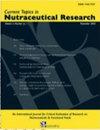The Effects of Medium-Term Intake of Hydrogen-Rich Water on Sperm Quality Biomarkers in Normospermic and Oligospermic Men: A Randomized Controlled Pilot Trial
IF 0.4
4区 医学
Q4 NUTRITION & DIETETICS
Current Topics in Nutraceutical Research
Pub Date : 2023-04-11
DOI:10.37290/ctnr2641-452x.21:182-186
引用次数: 0
Abstract
The main aim of this randomized controlled pilot trial was to evaluate the effects of hydrogen-rich water on spermiogram parameters in normospermic and oligospermic men. As many as 12 healthy young men (age 29.1 ± 5.9 years; n = 6 normospermic; n = 6 oligospermic) volunteered. Participants were allocated in a double-blind manner to receive 1 L of hydrogen-rich water per day or 1 L of tap water fortified with magnesium for 8 weeks. Following hydrogen-rich water supplementation, sperm concentration and morphology tended to increase by 12.4 million per milliliter (95% CI; –31.8 to 56.6), and live cells increased by 3.8% (95% CI; –12.5 to 20.1), respectively (P ≤ 0.30). A significant difference between the two interventions was found in sperm vitality (P = 0.03), with hydrogen-rich water being superior to the placebo in terms of an increase in the number of live sperm cells. Subgroup analyses revealed no significant differences between interventions in sperm viability outcomes in oligospermic men (P > 0.05). However, sperm count increased by over 20 million in two of the three oligospermic men (66.7%) receiving hydrogen-rich water, while no oligospermic men in the placebo group increased sperm concentration to euspermic levels (P < 0.01). These preliminary findings suggest hydrogen-rich water is an effective intervention for improving some aspects of male subfertility; further large-sample trials are warranted to corroborate our results.中期摄入富氢水对正常精子和少精子男性精子质量生物标志物的影响:一项随机对照试验
这项随机对照先导试验的主要目的是评估富氢水对正常精子和少精子男性精子图参数的影响。健康青年男性12人(年龄29.1±5.9岁;N = 6;N = 6,少精子)自愿。参与者以双盲方式被分配,每天接受1升富氢水或1升加镁的自来水,持续8周。补充富氢水后,精子浓度和形态倾向于每毫升增加1240万个(95% CI;-31.8至56.6),活细胞增加3.8% (95% CI;-12.5 ~ 20.1) (P≤0.30)。两种干预措施在精子活力方面存在显著差异(P = 0.03),富氢水在活精子细胞数量增加方面优于安慰剂。亚组分析显示,不同干预措施对少精子男性精子生存能力的影响无显著差异(P < 0.05)。然而,在接受富氢水治疗的三名少精子男性中,有两名(66.7%)精子数量增加了2000多万,而安慰剂组的少精子男性精子浓度没有增加到原精子水平(P < 0.01)。这些初步研究结果表明,富氢水是改善男性不育某些方面的有效干预措施;需要进一步的大样本试验来证实我们的结果。
本文章由计算机程序翻译,如有差异,请以英文原文为准。
求助全文
约1分钟内获得全文
求助全文
来源期刊
CiteScore
1.10
自引率
0.00%
发文量
36
审稿时长
>12 weeks
期刊介绍:
Current Topics in Nutraceutical Research is an international, interdisciplinary broad-based peer reviewed scientific journal for critical evaluation of research on chemistry, biology and therapeutic applications of nutraceuticals and functional foods. The major goal of this journal is to provide peer reviewed unbiased scientific data to the decision makers in the nutraceutical and food industry to help make informed choices about development of new products.
To this end, the journal will publish two types of review articles. First, a review of preclinical research data coming largely from animal, cell culture and other experimental models. Such data will provide basis for future product development and/or human research initiatives. Second, a critical evaluation of current human experimental data to help market and deliver the product for medically proven use. This journal will also serve as a forum for nutritionists, internists, neurologists, psychiatrists, and all those interested in preventive medicine.
The common denominator of all of the topic to be covered by the journal must include nutraceuticals and/functional food. The following is an example of some specific areas that may be of interest to the journal. i) Role of vitamins, minerals, antioxidants and phytonutrients on cardiovascular health, cancer, diabetes, ocular health, mental health, men’s health, women’s health, infant nutrition, ii) Role of herbals on human health, iii) Dietary supplements and sleep, iv) Components of diet that may have beneficial effect on human health, v) regulation of apoptosis and cell viability, vi) Isolation and characterization of bioactive components from functional foods, vii) Nutritional genomics, and viii) Nutritional proteomics.

 求助内容:
求助内容: 应助结果提醒方式:
应助结果提醒方式:


